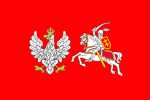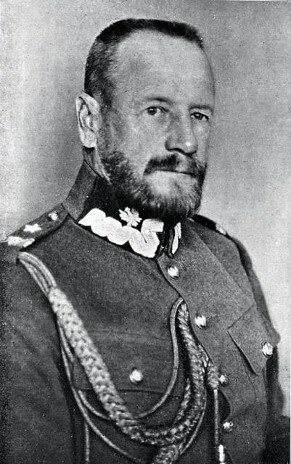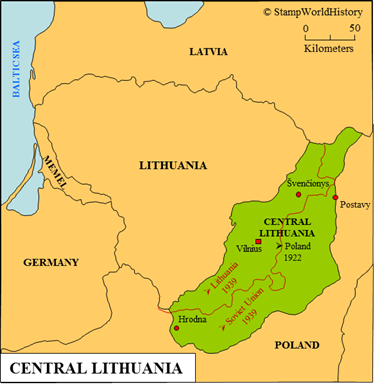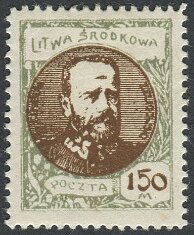
Central Lithuania
Quick reference
General issues: Republic 1920-1922
Country name on general issues: Środkowa Litwa
Currency: 1 Marka = 100 Fenigi
Population: 489 000 in 1922
Political history Central Lithuania
Prelude
Central Lithuania is located in northern Europe centered around the city of Vilnius. Vilnius was the capital of the grand duchy of Lithuania until Lithuania became part of the Russian empire in the 18th century. Within the Russian empire, Vilnius was administered as the Vilnius governate.[1]In imperial Russia, a governate was the administrative level just below the national level. In WWI, Vilnius was occupied by Germany in 1915 and was made part of the area administered by the Oberbefehlshaber Ost.[2]The Oberbefehlshaber Ost was the supreme commander of the German forces on the Russian front during WWI. For a map of the area controlled by the Oberbefehlshaber Ost, please refer to the map of Germany 1914-1938.
The 1917 Russian Revolution brought civil war to Russia and ethnic minorities across the empire proclaimed independence. Thus, Lithuania, while still under German occupation, proclaimed independence in 1918 and claimed Vilnius as a historical part of the former grand duchy of Lithuania. After the capitulation of Germany ending WWI in November 1918, Russia sought to regain control over the countries that had broken away from the Russian empire and invaded Lithuania. Lithuanian forces successfully countered the Russian invasion and, by October 1919, the Russian forces were driven out of the country. In July 1920, Russia recognized Lithuanian independence by way of the Treaty of Moscow. The border was agreed upon as part of the treaty – Vilnius was awarded to Lithuania.
The republic of Central Lithuania

Lucjan Żeligowski established the republic of Central Lithuania. After the annexation of Central Lithuania by Poland, Żeligowski continued a career in the Polish military and politics.
However, Poland also claimed Vilnius because of its majority Polish population. Poland had declared independence in 1918 – just like Lithuania – and was engaged in several territorial disputes supervised by the League of Nations. To avoid a confrontation with the League of Nations, Poland did not engage in a direct conflict with Lithuania over Vilnius. Instead, Poland staged the mutiny of a division of the Polish army, led by Lucjan Żeligowski.[3]The 1st Lithuanian-Belarusian Infantry Division, composed, mainly, of Lithuanian and Belorussian troops. Żeligowski engaged and successfully drove back the Lithuanian forces, gaining control of Vilnius in October 1920. Subsequently, Żeligowski established the republic of Central Lithuania. A truce was signed in November 1920 and negotiations started under the auspices of the League of Nations. Elections, planned for January 1921, were postponed pending the negotiations. The negotiations became a long drawn out process. Elections were, finally, held in January 1922. In February 1922, the newly elected parliament of Central Lithuania adopted a motion requesting association with Poland. The Polish parliament obliged in March 1922 and Poland annexed Central Lithuania in April 1922. The League of Nations accepted the de facto situation in February 1923.[4]One of the reasons for accepting the annexation of Central Lithuania by Poland was the annexation of the Memel region by Lithuania in January/February 1923. A demarcation line set by the League of Nations came to serve as the de facto border from March 1923.
Aftermath
Lithuania did not de jure accept the settlement and broke off diplomatic relations with Poland until 1938. In 1939, after the Soviet Union had occupied eastern Poland, the Soviet Union awarded part of what had been the republic of Central Lithuania to Lithuania.[5]The Soviet Union was compensated by the right to station Soviet forces in Lithuania. After WWII, the 1939 Lithuanian borders were reconfirmed, and the borders established then are the borders as we know them today.
Postal history Central Lithuania
Central Lithuania issued its first stamps in October 1920 – depicting the coat of arms of the republic. A set of provisionals followed in November 1920 – Lithuanian stamps overprinted ‘Środkowa Litwa’ for ‘Central Lithuania’, the coat of arms and a new denomination. A set of semi postals was issued, in 1921, to support the referendum in Upper Silesia – one of the territories Poland also claimed. Central Lithuania issued stamps until February 1922. All stamps were issued both perforate and imperforate. The issues have themes of national interest.
Album pages
← Previous page: CampioneNext page: Denmark →





